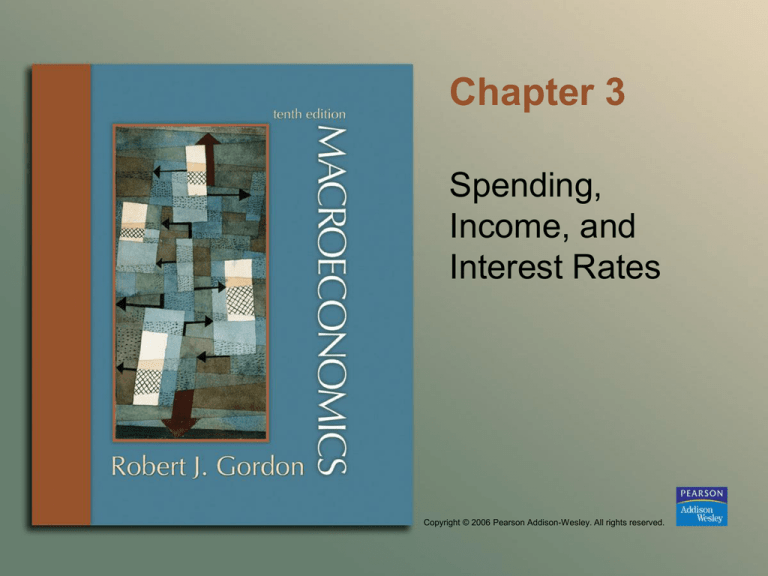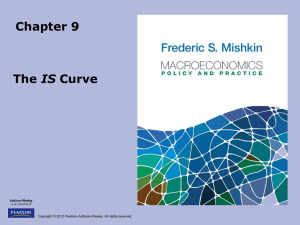
Chapter 3
Spending,
Income, and
Interest Rates
Copyright © 2006 Pearson Addison-Wesley. All rights reserved.
Figure 3-1 Real GDP Growth
in the United States, 1950–2004
Copyright © 2006 Pearson Addison-Wesley. All rights reserved.
3-2
In economies there endogenous and exogenous variables
•
Endogenous variables are variables that are explained by economy.
•
Exogenous variables are variables that are taken AS GIVEN and not
explained by the economy.
•
For example, for this chapter we assume interest rates and investment
are taken as given (exogenous) and we try to look at what happens the
Consumption and output (GDP) ( both endogenous) whenexogenous
variables change.
•
We should distinguish between planned and unplanned.
•
The latter ones might be different because of their impact on
equilibrium.
Copyright © 2006 Pearson Addison-Wesley. All rights reserved.
3-3
Consumption Function
• Consumption is a function of disposable income, that is income
left after taxes have been paid off.
• C = Ca + c (Y-T)
• The Ca is the autonomous consumption, that is, the part of
consumption independent of income. When Y-T =0, there is still
a consumption C =Ca.
• How come this could be possible ?
• By borrowing of course.
• ΔC / Δ(Y-T) = c and you remember what it was...
Copyright © 2006 Pearson Addison-Wesley. All rights reserved.
3-4
Figure 3-2 A Simple Hypothesis
Regarding Consumption Behavior
Copyright © 2006 Pearson Addison-Wesley. All rights reserved.
3-5
Figure 3-3 Consumption, Saving,
and Disposable Income, 1929–2004
Copyright © 2006 Pearson Addison-Wesley. All rights reserved.
3-6
Ep =C +Ip + G+ NX
•
The total expenditures can be broken down into two components.
•
One component includes all expenditures which are planned, that is
there is NO UNEXPECTED spending.
•
The other component involves UNEXPECTED or UNPLANNED
expenditures.
•
The subscript “p” means planned.
•
Here we assume ALL others are planned and Investment (I) however
has planned (P) and unplanned (u) components.
• Since Ep only includes planned expenditures, naturally only the
planned component of Investment enter this equation.
•
We can expand the C = Ca +c(Y-T) so you remember the first term is
autonomous component. The second term, that is c(Y-T) is induced
component of consumption, that is as (Y-T) changes so does that part
of consumption.
Copyright © 2006 Pearson Addison-Wesley. All rights reserved.
3-7
We can now extract the autonomous component of total spending.
•
Call autonomus component as Ap.
•
So Ap = Ep - cY = Ca +cTa + Ip + G+ NX
•
Attention FOR THE TIME BEING we assume the taxes are
autonomous so T = Ta.
•
On the right hand side of equation we see that autonomous spending
consists of all planned spending that do not depend on income.
•
What I have done above is simple: I subtracted the induced part of
expenditures from all expenditures thus elaving the autonomous part.
•
We know that economy is in equilibrium as long as actual expenditure
(E) is equal to income.
•
If ofr some reason either E > Y or Y > E there is disequilibrium, in the
first case spending is more than income in the second case the
opposite is true. In this case, in the next round production will adjust
accordingly.
Copyright © 2006 Pearson Addison-Wesley. All rights reserved.
3-8
Figure 3-4
How Equilibrium Income Is Determined
Copyright © 2006 Pearson Addison-Wesley. All rights reserved.
3-9
So how do we interpret this graph?
•
When Y = 6000, there is equilibrium, that is the expenditures (C +G +I)
are equal to total income.
•
But when Y = 8000, at this level , pluging this into equation we find the
spending is LESS than income. It can be calculated to be equal to
7500.
•
What happens to $500, which is NOT spent.?
•
This is called Inventory Investment and it is unplanned because this is
value of goods waiting to be shipped to the customers but not SOLD.
•
So stock of goods of that amount are piling up and business did not
plan this way, that is why it is UNPLANNED.
•
To bring the inventories back to its desired level, business react by
cutting production.
•
But Cutting production means....
•
Cutting incomes (less spent on labor and capital creating less income).
Copyright © 2006 Pearson Addison-Wesley. All rights reserved.
3-10
Table 3-1 Comparison of the Economy’s
“Always True” and Equilibrium Situations
Copyright © 2006 Pearson Addison-Wesley. All rights reserved.
3-11
We will use Y = Ep +Iu and this equality is true everywhere.
•
Only at equilibrium when expenditures are equal to income the
unpanned part vanishes.
•
Now subtract cY from both sides and let us assume we are at the
equilibrium so Iu zero.
•
Y-cY = Ep – cY
•
Remember the right hand side is Ap.
•
(1-c)Y = Ap
•
İf c is marginal propensity to consume MPC, then (1-c) is MPS.
•
So let us use “s” to represent MPS. The sY = Ap.
•
Suppose MPC is 0.75 (out of every $1 increase in income, $0.75 extra
is spent on consumption).
•
Note that sY is a leakage so if it is equal to Ap, then saving is spent on
autonomous spending.
•
We can then rewrite Y = Ap/ s for equilibrium.
Copyright © 2006 Pearson Addison-Wesley. All rights reserved.
3-12
Figure 3-5 The Change in Equilibrium
Income Caused by a $500 Billion Increase in
Autonomous Planned Spending
Copyright © 2006 Pearson Addison-Wesley. All rights reserved.
3-13
Now business become optimistic about future..
• And let us put numerical values in place of variables...
• Ca = 500, c = 0.75, Ip = 1200 and NX =-200..G and Ta are set
equal to zero (no government expenditures and taxes)..
• Then Ap = 500- 0.75(0) + 1200 +0-200 = 1500.
• Planned investment increase, say by $500...
• Remembering the equality Y = Ap /s.
• Y = $1500 and since Ep = Ap +cY Ep=1500+0.75Y
• We find initial equilibrium as Y = 1500 / 0.25 =6000.
• But Now business become optimistic about future...so additional
investment (planned) is made, let us say =$500.
• Then Ap =$2000 so new Y = 2000/0.25 =8000.
• What do these mean
Copyright © 2006 Pearson Addison-Wesley. All rights reserved.
3-14
Figure 3-8 Relation of the Various Components
of Autonomous Planned Spending to the
Interest Rate
Copyright © 2006 Pearson Addison-Wesley. All rights reserved.
3-15
Figure 3-9 Relation of the IS Curve to the
Demand for Autonomous Spending
Copyright © 2006 Pearson Addison-Wesley. All rights reserved.
3-16









